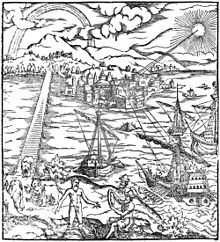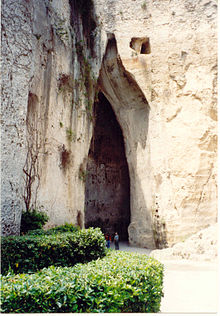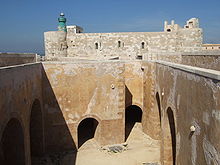History of Syracuse
The history of the city of Syracuse began in 734 BC. BC, when Greek settlers founded the city of Syracuse ( ancient Greek Συράκουσαι Syrákusai ) on the southeast coast of Sicily . In the centuries that followed, the city developed into the largest and most powerful city of ancient Sicily and its cultural center. For a long time Syracuse was able to withstand the attacks of foreign conquerors. 212 BC It came under the rule of the Romans and became the first Roman provincial capital. Under Arab rule in the 9th century, Syracuse lost its supremacy to Palermo , which was expanded to become the new capital of Sicily.
Today Syracuse is Sicily's fourth largest city and the capital of the Syracuse Free Community Consortium . Due to the archaeological sites and buildings that reflect the history of the city from its foundation to modern times, UNESCO declared Syracuse a World Heritage Site in 2005 .
prehistory
Bronze age
In the area around Syracuse settled from about the middle of the 2nd millennium BC. BC people whose legacies can be linked to the Bronze Age Thapsos culture . From the 14th century BC After Thapsos , Scoglio del Tonno (Taranto) and Lipari , the place where Syracuse was later founded seems to have developed into one of the most important trading stations between the eastern and western Mediterranean. The time before the Greek colonization of Syracuse has not yet been well researched, but the sporadic finds from the Bronze Age included a. Mycenaean and Cypriot ceramics as well as a cylindrical seal of Eastern Mediterranean origin. In the 13th century, many coastal settlements in eastern Sicily were destroyed or abandoned, especially in the region of Syracuse. The legacies of new residents show strong ties to mainland Italy, in contrast to the previous Thapsos culture. These events can probably be connected with the arrival of the Sikeler in eastern Sicily, described in ancient sources , during which the previous population - the Sicans of ancient sources - was displaced to the west.
Greek antiquity
Archaic time
The place name was derived from the extensive swamp area Syrákō , which was located on the banks of the rivers Anapo and Ciane , which flow into the Mediterranean .
In 734 BC Under the leadership of Archias , Doric settlers from Corinth subjugated the Sikeler people, settled on the island of Ortygia and founded the city of Syrákusai . The 40 hectare island is only separated from the mainland by a narrow passage between two natural harbors and was therefore easy to defend.
Due to the favorable location on the Ionian Sea , which enabled trade with Corinth and other cities in the eastern Mediterranean, the city became wealthy and quickly expanded to the mainland, where the Achradina district emerged. Daughter towns were also founded, as in 664 BC. Chr. Akrai , 644 v. BC Kasmenai and 589 BC Chr. Kamarina .
From 580 B.C. The city minted its own coins. In circulation were z. B. Tetradrachms depicting a charioteer with a team of four, corresponding to the value of four drachms, and the head of the Greek nymph Arethusa with four dolphins. According to legend, Arethusa was once transformed into the freshwater spring that rises on Ortygia. Around 575 BC The Temple of Apollo , the oldest known Greek temple in Sicily, was built.
Elderly tyranny
At the beginning of the 5th century BC The city population rebelled against the rule of the wealthy Gamoroi (also Geomoroi , "landowners"), who formed a legally privileged aristocratic class. According to the meaning of the name, the Gamoroi were descendants of people who were given land by raffle during the original land distribution during settlement. They have now been driven out of the city. Gelon , the tyrant of Gela, took advantage of the unrest, seized sole rule and was thus 485 BC. First tyrant of Syracuse. He helped the Gamoroi return to the city and enslaved the dispossessed population.
Under Gelon's rule, Syracuse became the capital of eastern Sicily and continued to expand. Around the districts of Ortygia and Achradina three new districts were created: Tyche, Neapolis and, on a hill in the northwest, Epipolai. Around 480 BC There was a war between Gelon and the Carthaginians . With the help of his father-in-law Theron , he defeated the attackers in the battle of Himera . On the occasion of this victory, he had the Temple of Athena built on Ortygia , around which the cathedral was later built, and other temples in Neapolis.
After Gelon's death in 478 BC His brother Hieron I took over the rule. He defeated the Etruscans in the Battle of Kyme and turned Syracuse into a cultural center. He gathered poets like Simonides von Keos , Epicharmos , Aeschylus and Pindar at his court and had a theater built, which today is one of the largest theaters of ancient Greece. It offered space for 15,000 spectators.
When Hieron I around 466 BC Died, followed by his younger brother Thrasybulos , who was overthrown after just under a year because of his cruelty. The city celebrated this event from now on with an annual festival of sacrifices in honor of Zeus.
With the overthrow of Thrasybulus, the rule of the first three tyrants of Syracuse, the so-called elder tyranny, ended . From 466 to 405 BC In BC Syracuse experienced a phase of democracy that resembled the political system in Athens . In the Ekklesia , the people's assembly, laws were passed, decisions on foreign policy and the military were made, and state officials and a council were elected. However, the differences in class were not eliminated. The authoritative leaders continued to come from a wealthy elite. Around 450 BC BC succeeded, together with Akragas, in suppressing an uprising by the Sicilian prince Duketios and in expanding the dominance of the city.

During the expedition to Sicily from 415 to 413 BC In BC Syracuse was besieged by a force from Athens , but they were defeated. 7,000 Athenians were captured and taken to the Latomien, the ancient stone quarries of Syracuse, which also served as a prison.
Younger tyranny
With Dionysius I , the 405 BC BC seized power, the younger tyranny began. After several armed conflicts with Carthage, he secured Syracuse through peace treaties and built the city into the most powerful fortress in Sicily. A wall ring was built around the city area and a large fortification, the fortress Euryalos , was built in the elevated district of Epipolai . At that time Syracuse had about 125,000 inhabitants.
Dionysius I extended his sphere of influence further. He founded new cities like Adranon and Tyndaris and conquered Rhegion . After his death in 367 BC His son Dionysius II followed , who was temporarily expelled from Syracuse, but not until 344 BC. Was forced to abdicate by Timoleon from Corinth. Timoleon temporarily reintroduced democracy in his role as aisymnet (mediator).
After Timoleon's abdication in 337 BC There were riots in the city. During an uprising in 317 BC Agathocles succeeded in seizing power. He appeared as a defender of the common people against the wealthy aristocracy and was the first tyrant from 304 BC onwards. The title "King of Sicily". After his death in 289 BC Unrest and uprisings followed again and in 278 BC. BC Syracuse asked King Pyrrhus for support in the fight against Carthage. He took advantage of the situation and subjugated almost all of Sicily, but had to surrender in 276 BC. Move back to Italy.
Thereupon 275 BC took over Chr. Hieron II. The rule in Syracuse and helped the city to a long prosperity. He concluded peace treaties with the Romans , who had driven out the Carthaginians at the end of the First Punic War and conquered all of Sicily except for Syracuse, and assured them of grain deliveries.
He created a new tax law, the Lex Hieronica , promoted agriculture and trade and brought scholars like Archimedes and artists like the poet Theocritus to his court. He had the theater rebuilt and a sacrificial altar almost 200 m long and over 10 m high was built for the annual festival in honor of Zeus.
After Hieron's death in 215 BC His grandson Hieronymos seized power. This turned away from Rome and sided with Carthage in the Second Punic War . As a result, Roman troops besieged Syracuse. Archimedes developed a number of machines of war to defend the city and allegedly used burning mirrors to set the sails of Roman ships on fire. But under the leadership of Marcus Claudius Marcellus , the Romans finally succeeded in 212 BC. To take the Euryalus fortress and conquer the city.
List of rulers
The years given refer to the reigns.
- Gelon of Gela (485–478 BC)
- Hieron I , Gelon's brother (478–467 / 466 BC)
- Thrasybulus , Hieron's brother (467 / 466–465 BC)
- Democracy (465–405 BC)
- Dionysius I (405–367 BC)
- Dionysius II , his son (367–357 BC)
-
Dion (357–354 BC)
- Kallippus rival (354–353 BC)
- Hipparinos and Aretaios, rivals (353–351 BC)
- Nysaios (351–347 BC)
- Dionysius II , for the 2nd time (347–344 BC)
- Timoleon as Aisymnet (344–337 BC)
- Oligarchy (337-317 BC)
- Agathocles (316–289 BC, from 304 BC as king)
- Hiketas (289–280 BC)
- Toinon (280 BC)
- Sosistratos (280-277 BC)
- Epirotic rule (277–275 BC)
-
Hieron II (275–215 BC, from 260 BC as king)
- Gelon II , co-regent (240–216 BC)
- Jerome (215–214 BC)
-
Adranodorus (214–212 BC)
- Hippocrates , co-regent (213–212 BC)
- Epikydes , co-regent (213–212 BC)
- Syracuse is taken over by the Roman Republic
Roman antiquity
With the conquest of Syracuse, all of Sicily was now under Roman rule. It became the first Roman province of Sicilia with Syracuse as the provincial capital and seat of the praetor , the governor.
According to legend, Christianity spread in Syracuse as early as 44, when the apostle Paul is said to have spent a few days here on his way to Rome. However, the first Christian burials cannot be proven before the beginning of the 3rd century. The catacombs of Syracuse were built around the tomb of St. Marcians, the first bishop of Syracuse, from 315 , which are among the largest underground tombs after the catacombs of Rome.
In the 3rd century a Roman amphitheater was built. It could be filled with water, so that not only gladiator fights took place here, but also sea battles were re-enacted.
After the fall of the Western Roman Empire, Syracuse came under the rule of the Vandals and then the Ostrogoths around the middle of the 5th century . In 535 Sicily was conquered by the Eastern Roman general Belisarius and reintegrated into the Roman Empire . Since that time there has been a renewed spread of the Greek language in eastern Sicily, which had previously been replaced by Latin.
middle Ages
Byzantine domination
For more than three hundred years Syracuse remained part of the Eastern Roman or Byzantine Empire and from 663 onwards, under Emperor Constantine II, it was even its seat of government, since Constantinople was threatened by the Arabs and the emperor apparently wanted to set up a new fleet in Syracuse. His successor Constantine IV , however, moved the residence back to Constantinople in 669. Nevertheless, Syracuse remained an important base for the Byzantine fleet.
Arab domination
From 827 onwards, the Arabs gradually took Sicily. A first attempt to conquer Syracuse failed because a plague epidemic broke out in the city and the attacking troops had to withdraw. In 831 Palermo fell under the rule of the Arabs and Syracuse lost its supremacy as the capital of Sicily.
On May 21, 878, Syracuse finally came under Arab rule and remained a center of Islam in Italy until 1038 . Arabs invaded the city, killed most of the residents, ransacked the houses and set them on fire. The Cathedral of Syracuse, which was built around the former Temple of Athens in the 7th century, now served as a mosque. The surviving Christian population could live according to their own religious rules, but had to pay taxes.
The supremacy of the Arabs in Syracuse ended in 1038 when the Byzantine general Georg Maniakes conquered the city and built the later so-called Castello Maniace on Ortygia .
Normans and Hohenstaufen
The renewed Byzantine rule ended after less than 50 years: In 1086 Syracuse came under Norman rule after a long siege by Roger I. Under him and his successor Roger II the Christian faith flourished again. Syracuse became a diocese and many church buildings were expanded and redesigned.
After a short period of Genoese rule, Emperor Friederich II took over the city from the Staufer family in 1221 . He had the Castello Maniace rebuilt and the Bishop's Palace and Palazzo Bellomo built.
In 1266 Syracuse came under the rule of Anjou , then under the rule of Aragon .
Modern times
In 1693 a devastating earthquake struck the Val di Noto , which also affected Syracuse. Many buildings such as the city's cathedral , other church buildings and palaces were rebuilt in the Baroque style.
Politically, Syracuse came to Savoy from 1713 , to the Habsburgs from 1720 and to the Spanish Bourbons from 1735 . Due to the mismanagement of the Bourbons, there were repeated unrest and in 1848 an uprising, as a result of which Syracuse had to cede its role as regional capital to Noto . Only after the union with Italy in 1861 was Syracuse declared the regional capital again in 1865.
From 1870 on, the old city walls were removed and the Ponte Nuovo, a new bridge between Ortygia and the mainland, was built. Archimedesplatz, the center of Ortygia, was given its present appearance by the Artemis Fountain. With the construction of a railway line from Messina via Catania to Syracuse, the central station and the station at the port were created.
Economic upturn began at the beginning of the 20th century, when Syracuse proved to be a strategically located port city for the Italian colonies in North and East Africa. During World War II , the city fell victim to Allied bombing and the British invaded in 1943 as part of Operation Husky .
After the war, Syracuse expanded. While new housing estates developed on the mainland and large industrial areas in the north of the city, the old town threatened to deteriorate on Ortygia as the residents moved to the modern residential areas on the outskirts. Extensive renovation and restoration work began in 1990 and the old town was revitalized and revitalized.
Syracuse today
Today Syracuse is Sicily's fourth largest city with around 123,000 inhabitants and one of the economic and tourist centers.
In 2005, UNESCO declared Syracuse, together with the Pantalica necropolis, a World Heritage Site. The explanatory statement states: “ The group of buildings and archaeological sites that lie in Syracuse (from the core on Ortigia to the remains scattered throughout the city) is the best example of an excellent architectural achievement, the various spanning cultural aspects (Greek, Roman, Baroque). Ancient Syracuse was directly linked to events, ideas and literary works of outstanding global importance. "
The ancient buildings and finds are mostly on Ortygia as well as in the Parco Archeologico della Neapoli and in the Regional Archaeological Museum of Syracuse.
literature
- Eva Gründel, Heinz Tomek, Sicily , DuMont Buchverlag, Cologne, 5th edition 2001, ISBN 3-7701-3476-1
Individual evidence
- ↑ Alessandra Giumlia-Mair: Trade and raw material extraction in Italy of the late Bronze Age , in: The ship of Uluburun, world trade 3000 years ago . Catalog of the special exhibition in the German Mining Museum Bochum in 2005 (2005), p. 417f.
- ^ Robert Leighton: Sicily Before History: An Archaeological Survey from the Palaeolithic to the Iron Age. , Cornell University Press, 1999, p. 154 (with evidence)
-
↑ Thucydides , The Peloponnesian War 6, 2.
Diodor , Bibliothéke historiké 5, 6, 3. - ↑ Moses I. Finley : The ancient Sicily. From prehistory to the Arab conquest , CH Beck Munich (1979), 33f.
- ↑ Polybios Historien VIII.5–8.
- ↑ Unesco list







